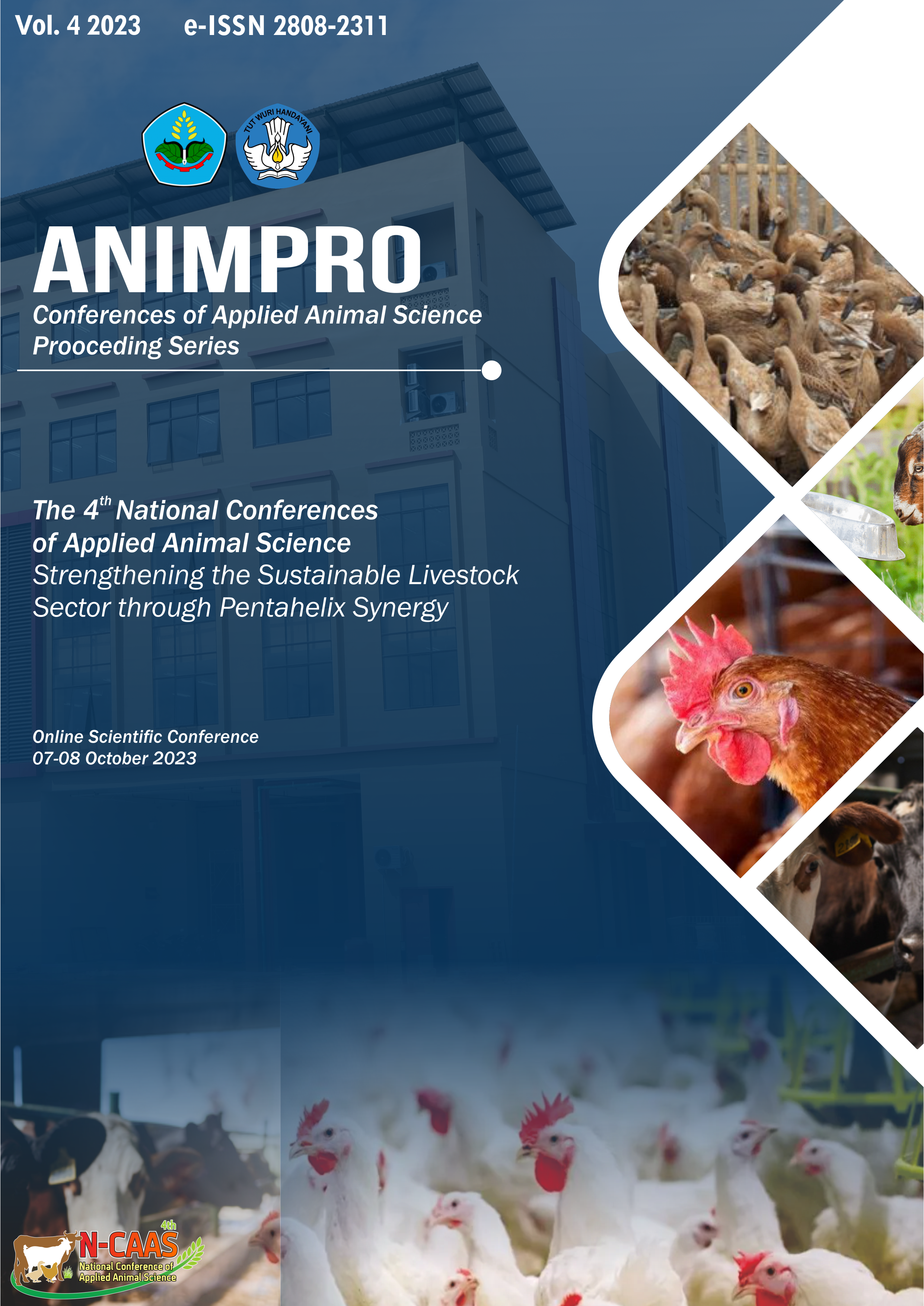Fermentasi biji karet (Hevea brasiliensis) menggunakan kapang yang berbeda terhadap organ limfoid dan hati ayam kampung
DOI:
https://doi.org/10.25047/animpro.2023.556Keywords:
native chicken, rubber seed, liver, Neurospora, lymphoid organs, Rhizopus spAbstract
This research was conducted to determine the effect of the addition of fermented rubber seed flour as a feed mixture on the internal organ weight of native chickens. This study used 90 native chickens. The treatments in this study were P0 (without treatment): P1 (Rhizopus oligosporus 5%) : P2 (Neurospora sitophila 5%) The parameters measured were the relative weight of the thymus organ, the relative weight of the spleen organ, the relative weight of the bursa of Fabrisius organ, and the relative weight liver organs. The experimental design in the study used RAL (Completely Randomized Design). The data obtained was analyzed using Analysis of Variance (ANOVA), if there was a significant difference (P<0.05) then it would be continued with the Duncan Multiple Range Test (DMRT) with 3 treatments and 5 replications. Based on the research results, the administration of rubber seed flour using Rhizopus oligosporus 5% and Neurospora sitophila 5% in feed rations had no significant effect (P>0.05) on the relative weight of the thymus organ, relative weight of the spleen organ, relative weight of the bursa of Fabricius, and relative weight of the liver. The conclusion of the study was that fermenting rubber seeds using Rhizopus oligosporus and Neurosphora sitophila at a dose of 5% in mixed feed did not cause a negative effect on the weight of lymphoid organs and chicken livers.Downloads
References
Ardiansyah, P., Suprijatna, E., & Kismiati, S. (2021). Pengaruh Penambahan Kupas Ubi Kayu dan Bakteri Asam Laktat sebagai Aditif Pakan Terhadap Berat Badan Organ Kekebalan Ayam Asli Super. Jurnal Sain Peternakan Indonesia, 16, 334–339.
Arfanda, A. I., Suprijatna, E., & Isroli. (2019). Pengaruh Frekuensi dan Periode Pemberian Pakan terhadap Bobot Relatif Organ Limfoid Ayam Buras Super. Jurnal Sain Peternakan Indonesia, 14(3), 306–311.
Damanik, M. R., Siti, N. ., & Sukmawati, N. M. S. (2022). Pengaruh Penggantian Ransum Komersial Dengan Limbah Roti Terhadap Organ dalam Ayam Kampung Unggul Balitnak (KUB). Jurnal Peternakan Tropika, 3(1), 450–467.
Hasnita, Masyitha, D., & Budiman, H. (2017). Gambaran histologis bursa fabricus ayam kampung (Gallus gallus domesticus) pada umur berbeda. Jurnal Ilmiah Mahasiswa Veteriner, 1(3), 398–403.
Herlina, B., & Novita, R. (2022). Pemberian tepung biji karet dalam ransum terhadap bobot karkas, persentase giblet, persentase lemak abdomen burung puyuh (Coturnix coturnix japonica). Jurnal Ilmu Pertanian Kelingi, 2(1), 150–157. https://doi.org/10.58328/jipk.v2i1.65.
Kusnadi, E. (2009). Perubahan Malonaldehida Hati, Bobot Relatif Bursa Fabricius dan Rasio Heterofil/Limfosit (H/L) Ayam Broiler yang Diberi Cekaman Panas. Media Peternakan, 32(2), 318–320.
Moran, P. A., Graner, D. K., Rod Well, V. W., & Martin, D. W. (1992). Biokimia (Harper’s review of Biochemistry) (20th ed.). Jakarta: EGC.
Nova, K., Tantalo, S., Sutrisna, R., Darmawan, A., Kusuma, M. F. V., & Hasiib, E. ‘Azizah. (2021). Introduksi tepung daun singkong dalam ransum komersil terhadap penampilan produksi ayam kampung KUB. Jurnal Ilmiah Peternakan Terpadu, 9(1), 108–119. https://doi.org/10.23960/jipt.v9i1.p108-119.
Oboh, G., & Elusiyan, C. A. (2007). Changes in the nutrient and anti-nutrient content of micro-fungi fermented cassava flour produced from low- and medium-cyanide variety of cassava tubers. African Journal of Biotechnology, 6(18), 2150–2157. https://doi.org/10.1177/026010600701800405.
Pantaya, D., Wulandari, S., Yulinarsari, A. P., & Poernomo, H. (2023). Evaluation of rubber seed meal (Hevea brasiliensis) by fermentation method using Rhizopus oligosporus and Neurospora sitophila fungi. IOP Conference Series: Earth and Environmental Science, 1168(012039), 1–5. https://doi.org/10.1088/1755-1315/1168/1/012039.
Rahmawati, L., Ellya, H., & Iswahyudi, H. (2018). Kandungan Hidrogen Sianida (HCN) Daging Biji Karet Pada Berbagai Perlakuan Teknik Reduksi. Jurnal Teknologi Agro-Industri, 4(2), 53–60. https://doi.org/10.34128/jtai.v4i2.49.
Rizaty, M. A. (2022). Produksi Karet Alam Indonesia Naik 8,2% pada 2021. Retrieved July 21, 2023, from https://databoks.katadata.co.id/datapublish/2022/06/06/produksi-karet-alam-indonesia-naik-82-pada-2021#:~:text=Menurut data Badan Pusat Statistik,sebanyak 2%2C88 juta ton.
Sulistiyanto, B., Kismiati, S., & Utama, C. S. (2019). Tampilan Produksi dan Efek Imunomodulasi Ayam Broiler yang Diberi Ransum Berbasis Wheat Pollard Terolah. Jurnal Veteriner, 20(3), 352–359. https://doi.org/10.19087/jveteriner.2019.20.3.352.
Susanti, A. T. A., Isda, M. N., & Fatonah, S. (2014). Potensi alelopati ekstrak daun gleichenia linearis (Burm.) Underw. terhadap perkecambahan dan pertumbuhan anakan gulma Mikania micrantha (L.) Kunth. JOM FMIPA, 1(2), 1–7.
Tang, K., Fletcher, O., & Villegas, P. (1987). Comparative study of the pathogenicity of avian reoviruses. Avian Diseases, 31(3), 577–583.
Widiyawati, I., Sjofjan, O., & Adli, D. N. (2020). Peningkatan Kualitas dan Persentase Karkas Ayam Pedaging dengan Subtitusi Bungkil Kedelai Menggunakan Tepung Biji Asam (Tamarindus indica L) Fermentasi. Jurnal Nutrisi Ternak Tropis, 3(1), 35–40. https://doi.org/10.21776/ub.jnt.2020.003.01.7.
Downloads
Published
How to Cite
Issue
Section
License
Copyright (c) 2023 Prayogi Damar Waskito, Dadik Pantaya, Suci Wulandari, Alditya Putri Yulinarsari

This work is licensed under a Creative Commons Attribution 4.0 International License.









